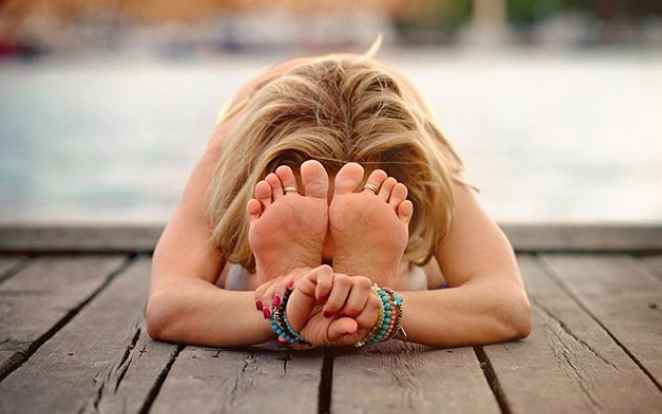Ayurveda, the sister science of yoga, is an ancient wellness system that can help us find optimal health and balance in life. It’s all about eating a nutritious and balanced diet that’s suited for your individual needs, engaging in self-care practices that nourish your body, mind and soul, plus, practicing yoga in a way that is informed by this ancient science of life. These three components are your Ayurvedic keys to good health and well-being.
Our October challenge, #EatLikeAYogi, is all about bringing yoga and Ayurveda together as they were meant to be practiced. In doing so, you will have all the tools you need to find your way back to a place of optimal well-being. During this challenge, each day, participants will complete an Ayurvedic practice (based on food and self-care) with Sahara Rose, and an Ayurveda informed yoga pose recommended by Kino.
Each of the yoga poses in this challenge have been selected based on their ability to help balance the doshas (Vata, Pitta, Kapha). As a compliment to the challenge, we are going to breakdown which poses are good for balancing which doshas, and why.
Today we’re talking about Vata imbalance and which yoga poses you should incorporate into your practice if you’re working to find balance.
A Vata imbalance is typically associated with many of the following signs and symptoms:
- Constipation
- Excess bloating and gas
- Poor mental focus
- Anxiety or excessive nervousness
- Cold hands and feet
- Physical weakness
- Dry Skin
- Irregular appetite
- Restlessness
- Trouble sleeping
- Hyperactivity
- And more
Does this sound like you? Participating in the October Challenge with Kino and Sahara Rose is a great place to start for finding your way back to a more balanced state. Plus, be sure to put more emphasis on the following Vata balancing yoga poses that Kino has recommended for the challenge:
Tree Pose – Since vata imbalance is usually associated with scattered thoughts, poor ability to focus, excessive nervousness and anxiety, balancing postures like tree pose can help to bring more stillness to the mind. Tree pose requires a keen mental focus, so try incorporating this pose into your daily practice to see if it helps.
Paschimottanasana – Forward folds are grounding, calming, and encourage introspection. This is why any forward fold is great for bringing balance to excess Vata. Try this pose in the evening before bed to ease hyperactivity and help you prepare for a more restful sleep.
Utkatasana – Chair pose is very effective for creating a sense of grounding, which is great for relaxing a Vata mind. Plus, it activates the downward moving force in our bodies (Apana Vayu) which can help when it comes to alleviating constipation.
Warrior II – This is another grounding pose that can really help with balancing excess Vata. This posture does however pose a challenge for those of us who may be experiencing a Vata imbalance. This is because it’s a little less interesting than some of the other postures on this list. Vatas get bored very easily, but if you try incorporating a little movement with this pose before settling into stillness, you may find more success. Try this simple movement before settling in to hold Warrior II for an extended period of time: from Warrior II, inhale to lift your arms and bring the palms to touch. At the same time lengthen your front leg. On the exhale, bend back into your front knee, and extend the arms back in opposite directions. Repeat for several rounds of breath.
Ustrasana – The last pose on our list for balancing Vata is Ustrasana, aka camel pose. This pose is recommended because it asks us to still the mind and focus on grounding through the legs before adding in the backbend. That’s what’s really important for getting the full benefit out of this pose. From this place of grounding, move slowly and mindfully into the backbend, being extra careful not to overdo it.
Remember, a dedicated yoga practice that’s informed by Ayurveda is only part of what we need to do to find balance. Incorporate these poses into your daily practice and be sure to try the recipes and self-care routines recommended by Sahara Rose. This is what will truly help you find optimum health and bring balance to your overall life.
By Alex Wilson
Alex Wilson is a writer, yoga teacher, Ayurveda Yoga Specialist, and the content manager here at OMstars.com











